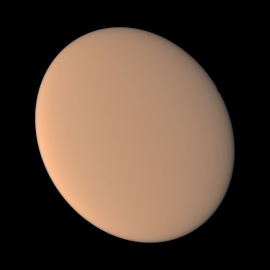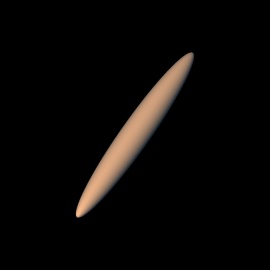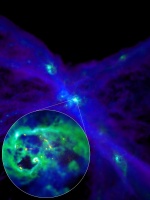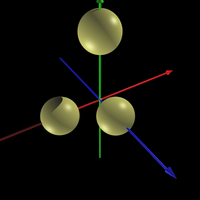Research
- Modeling the first interstellar visitor `Oumuamua
- Formation and evolution of dwarf galaxies
- Small-scale problems of cold dark matter cosmology
- Origin of globular clusters
- Impact of massive stars on interstellar medium
Modeling the first interstellar visitor `Oumuamua
`Oumuamua is the first visitor to the Solar system from outer space. It was briefly observed at the end of 2017 as an unresolved super-faint dot moving fast in the plane of sky. It was too small to be resolved, so its nature is still a mystery. Its brightness fluctuated dramatically (by a factor of 10 - larger than for any other minor body), suggesting an extremely elongated geometry. The popular explanation is that it has a cigar shape (see this artist's impression; credit: ESO/M. Kornmesser). This spurred my research interest into this object, as a cigar shape would require some serious fine-tuning (to make the cigar end almost precisely point in the direction of the observer on a regular basis) to make it produce large brightness fluctuations. A thin disk shape, on the other hand, would not have such an issue.
I spent around one year writing a GPU based code for modeling the rotational state evolution of `Oumuamua (or any other minor body which experiences tumbling and is subject to torque from outgassing). It is capable of finding all model parameters (between 8 and 14) by means of fitting model light curve to the observed one. After spending around one GPU-year on modern (P100) HPC GPUs, I found two best-fitting models - a cigar-shaped one, and a thin disk one. Both models needed some torque from outgassing to correctly match the observed brightness minima. Here are visualizations of the models (as seen by an Earth observer - if we had enough of resolving power), covering the same 5 days when most of observations were made (in late October 2017; click on the images to watch the animations):
(The red dot is to make it possible to see rotation around the axis of symmetry). Here is an artistic interpretation of my disk model (click on the image to watch the animation):
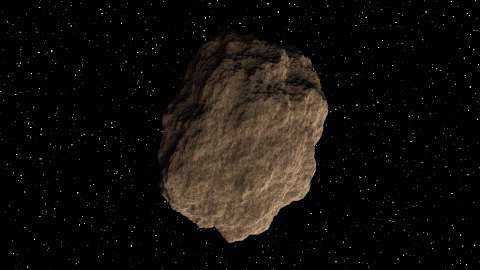
I estimated that the cigar-shaped model has only 16% chance to produce light curve minima as deep as the observed ones (by assuming that the initial angular momentum orientation is random - a sensible assumption for an interstellar visitor). The thin disk model, on the other hand, is almost guaranteed (at 91%) to produce such large brightness fluctuations.
My conclusions: 'Oumuamua is a thin disk (not a cigar-shaped object), with the size ~ 110 x 20 m, experiencing moderate torque from outgassing from its surface. The research was published in MNRAS (the arxiv version).
Formation and evolution of dwarf galaxies
Dwarf galaxies are observed in large numbers (in fact, they are the most common type of galaxies in the universe), they formed on average much earlier than their giant counterparts like our Milky Way galaxy, and they are much simpler systems (often - roughly spherical stellar blobs with no disks and gas, and very little star formation in the last 10 billion years). All of the above makes the dwarfs beautiful cosmological probes: it is much easier (computationally) to simulate the formation and evolution of these objects in a fully self-consistent way from "first principles" (that is - from the epoch of recombination when the universe was only 300,000 years old, which is directly observed in Cosmic Microwave Background experiments) than in the case of large galaxies. Dwarf galaxies is our primary theoretical target in the quest for bridging the mysterious and currently unobserved "dark ages" of the universe followed by the epoch of re-ionization (the time interval between redshifts z=1000...7).
Recently we carried out probably the most advanced computer simulations of a dwarf galaxy forming in the early universe (published in Science). We simulated the formation of a galaxy with the total (virial) mass of one billion solar masses at the redshift of 7, in a box with the size 4 co-moving megaparsecs. Our mass resolution was 2000, 400, and 100 solar masses for dark matter, gas, and star particles, respectively. This unprecedented resolution coupled with the inclusion of important physical processes usually ignored in cosmological simulations (such as radiative cooling of gas due to heavy elements at low temperatures, less than 10,000 K) allowed us to accurately reproduce the very violent nature of the formation of a dwarf galaxy:
Our primary goal was to try to resolve the so-called "cusp-core" problem of the standard cosmological model (see below). But our state-of-the-art simulations also allowed us to successfully reproduce some of the puzzling features of dwarf galaxies:
- Stellar population gradients. In many dwarf spheroidal galaxies, younger stars, richer in heavy elements, tend to concentrate toward the galactic centre.
- Low stellar density. The spatial density of stars is extremely low even at the galactic centre.
- Timing paradox for globular clusters. Previous, less advanced models predicted that globular clusters (large and dense clusters containing thousands of stars) should have spiraled in to the galactic centre over the lifetime of a dwarf galaxy; instead, in many dwarf galaxies globular clusters are observed at large distances from the centre. To reproduce the observed picture, in old models the timing of the arrival of globular clusters at their current locations had to be fine-tuned "by hands" (hence the "timing paradox").
It is remarkable, that our new mechanism which solves the "cusp-core" problem of cosmology (see below), also explains naturally the above astrophysical features of dwarf galaxies: violent interstellar medium (driven by exploding supernovae) gravitationally "heats" and kicks out from the galactic centre all kinds of matter (not just dark matter), including individual stars and globular clusters. This creates stellar population gradients (as stars which formed more recently were subject to the "heating" for shorter time and hence are more concentrated toward the galactic centre), dramatically reduces the central stellar density, and prevents globular clusters from "sinking" to the centre, keeping them at large distances - as observed.
Small-scale problems of cold dark matter cosmology
There is a serious discrepancy between cosmological simulations, which suggest that dark matter density should be divergent at the centre of galaxies (a cusp), and observations, which imply that galactic dark matter halos have constant density cores. In our recent Nature paper we showed that the violent nature of interstellar medium in small galaxies should result in a fraction of supernova energy transferred to dark matter particles, erasing the cusp on a short time scale (200 Myr). This animation illustrates the model we used in the paper, in which random bulk gas motions were modeled as three rigid spheres moving as harmonic oscillators through the centre of a live dark matter halo:
More recently, we presented self-consistent, state-of-the-art cosmological simulations of a dwarf galaxy forming in the early universe (Science, 2007) which confirmed our earlier result published in Nature. Specifically, we observed the gas clouds inside the forming galaxy to be pushed back and forth by supernovae explosions. This "sloshing" pushed most of dark matter (and stars) away from the galactic centre, resulting in the distribution of dark matter which matches the observed one. This mechanism also helps to explain other puzzling features of dwarf galaxies (see above).
Origin of globular clusters
Coming soon...
Impact of massive stars on interstellar medium
Coming soon...
*The animations on this page were created using open source programs Ifrit and blender. The animations are AVI files using DivX video codec. On modern Linux machines, they can be viewed with the program mplayer (which makes use of the library libavcodec to handle DivX files). On MS Windows PCs, the animations can be viewed with many different media players, including mplayer and open source program VLC. For most MS Windows players, you'll have to install the DivX codec first (free).
Also from this web page:

